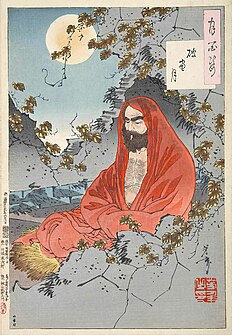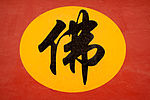
Back بودهيدهارما Arabic Bodhidharma AST Bodhidharma Azerbaijani Бодхидхарма Bashkir Бодхидхарма Bulgarian বোধিধর্ম Bengali/Bangla Bodhidharma Catalan بۆدیدارما CKB Bódhidharma Czech Bodhidharma Welsh
Bodhidharma
| |||||||||||||||||||||||||||||||||||||||||||||||||||||||||||||
|---|---|---|---|---|---|---|---|---|---|---|---|---|---|---|---|---|---|---|---|---|---|---|---|---|---|---|---|---|---|---|---|---|---|---|---|---|---|---|---|---|---|---|---|---|---|---|---|---|---|---|---|---|---|---|---|---|---|---|---|---|---|
 Bodhidharma, Ukiyo-e woodblock print by Japanese artist Yoshitoshi, 1887 | |||||||||||||||||||||||||||||||||||||||||||||||||||||||||||||
| Title | Chanshi 1st Chan Patriarch | ||||||||||||||||||||||||||||||||||||||||||||||||||||||||||||
| Religious life | |||||||||||||||||||||||||||||||||||||||||||||||||||||||||||||
| Religion | Buddhism | ||||||||||||||||||||||||||||||||||||||||||||||||||||||||||||
| School | Chan | ||||||||||||||||||||||||||||||||||||||||||||||||||||||||||||
| Senior posting | |||||||||||||||||||||||||||||||||||||||||||||||||||||||||||||
| Successor | Huike | ||||||||||||||||||||||||||||||||||||||||||||||||||||||||||||
Students
| |||||||||||||||||||||||||||||||||||||||||||||||||||||||||||||
| Part of a series on |
| Zen Buddhism |
|---|
 |
| Part of a series on |
| Chinese Buddhism |
|---|
 |
Bodhidharma was a semi-legendary Buddhist monk who lived during the 5th or 6th century CE. He is traditionally credited as the transmitter of Chan Buddhism to China, and is regarded as its first Chinese patriarch.[a] He is also popularly regarded as the founder of Shaolin kung fu,[1][2][3][4] an idea popularized in the 20th century,[3][4][1] but based on the 17th century Yijin Jing and the Daoist association of daoyin gymnastics with Bodhidharma.[2][1][b][c]
Little contemporary biographical information on Bodhidharma is extant, and subsequent accounts became layered with legend and unreliable details.[5][d] According to the principal Chinese sources, Bodhidharma came from the Western Regions,[6][7] which typically refers to Central Asia but can also include the Indian subcontinent, and is described as either a "Persian Central Asian"[6] or a "South Indian [...] the third son of a great Indian king."[7][e] Aside from the Chinese accounts, several popular traditions also exist regarding Bodhidharma's origins.[note 2] Throughout Buddhist art, Bodhidharma is depicted as an ill-tempered, large-nosed, profusely-bearded, wide-eyed non-Chinese person. He is referred to as "The Blue-Eyed Barbarian" (Chinese: 碧眼胡; pinyin: Bìyǎnhú) in Chan texts.[12]
The accounts also differ on the date of his arrival, with one early account claiming that he arrived during the Liu Song dynasty (420–479 CE) and later accounts dating his arrival to the Liang dynasty (502–557 CE). Bodhidharma was primarily active in the territory of the Northern Wei (386–534 CE). Modern scholarship dates him to about the early 5th century CE.[13]
Bodhidharma's teachings and practice centered on meditation and the Laṅkāvatāra Sūtra. The Anthology of the Patriarchal Hall (952) identifies Bodhidharma as the 28th Patriarch of Buddhism in an uninterrupted line that extends back to the Gautama Buddha himself.[14]
Cite error: There are <ref group=lower-alpha> tags or {{efn}} templates on this page, but the references will not show without a {{reflist|group=lower-alpha}} template or {{notelist}} template (see the help page).
- ^ a b c Shahar 2008, pp. 172–173.
- ^ a b Lin 1996, p. 183.
- ^ a b Henning 1994.
- ^ a b Henning & Green 2001, p. 129.
- ^ McRae 2003, p. 26-27.
- ^ a b Broughton 1999, p. 54–55.
- ^ a b Broughton 1999, p. 8.
- ^ Kambe 2012.
- ^ Zvelebil 1987, p. 125-126.
- ^ Cite error: The named reference
Krishnawas invoked but never defined (see the help page). - ^ Edou 1996, p. [page needed].
- ^ Soothill & Hodous 1995.
- ^ Encyclopedia of Buddhism. Vol. 1. MacMillan. 2003. pp. 57, 130.
- ^ Philippe Cornu, Dictionnaire enclyclopédique du Bouddhisme
Cite error: There are <ref group=note> tags on this page, but the references will not show without a {{reflist|group=note}} template (see the help page).
Cite error: There are <ref group=web> tags on this page, but the references will not show without a {{reflist|group=web}} template (see the help page).